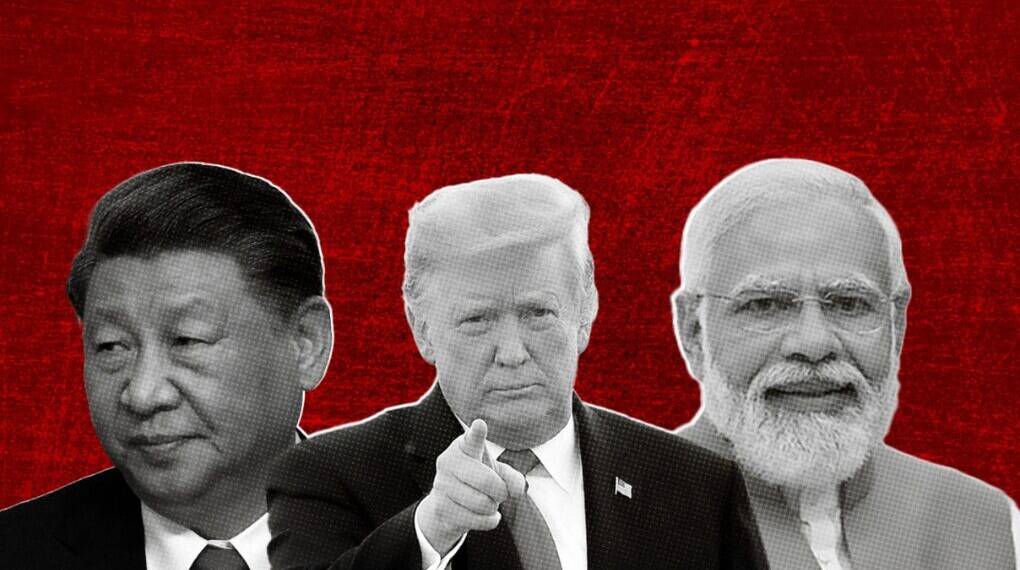The evolving dynamic between India and China amid the volatile Trump administration highlights a profound recalibration in South Asian geopolitics.
Their tentative rapprochement reflects a broader strategy of hedging, where both powers maneuver cautiously within an increasingly unpredictable global order dominated by unilateralism and erratic U.S. policies.
Hedging in the Age of Trump’s Unilateralism
In international relations, “hedging” describes how states mitigate risks by balancing cooperation and competition during periods of global uncertainty. This strategy aptly defines recent India-China moves.
The turbulence fueling this hedging stems largely from the mercurial policies of former U.S. President Donald Trump, whose “America First” doctrine upended decades of predictable diplomacy. Trump’s use of punitive tariffs and aggressive negotiations targeted countries worldwide, signaling a stark shift from global multilateralism to confrontational economic nationalism.
His administration’s belligerence forced many nations to reassess alliances, creating uncommon pressure on both established partners and rivals alike.
Reviving Multilateral Forums and Regional Cooperation
One notable fallout of this geopolitical turbulence has been a renewed focus on cooperative platforms involving India and China, such as BRICS and the Shanghai Cooperation Organisation (SCO).
While these forums cover broader Eurasian and global issues, their significance in the South Asian context has grown amid destabilizing U.S. policies. Trump’s threats of tariffs extended beyond traditional trade partners to BRICS members, including India and China, branding these coalitions as attempts to challenge U.S. dollar supremacy and undermine Western-led order.
This antagonistic rhetoric and economic coercion paradoxically nudged India and China toward closer engagement, fueling cautious diplomatic overtures despite lingering suspicions.
Domestic Challenges Driving China’s Calculations
China faces significant internal challenges—an irreversible economic slowdown, demographic decline, youth unemployment, and growing inequality. A rising number of Chinese youth are disengaged from employment or education, fueling social discontent and skepticism about meritocracy and upward mobility.
Facing these domestic constraints, Beijing seeks stable external markets and energy supply lines. The vast Indian market emerges as crucial, especially for commodities like steel, cement, and aluminum, where China’s production exceeds internal demand. This economic interdependence incentivizes China to ease tensions with India despite their strategic rivalry.
India’s Strategic Calculus in a Shifting Environment
India confronts a complex geopolitical landscape. The Trump administration initially took a hard line on China, aiming to curb Beijing’s technological and military advancements.
However, Trump’s sudden policy reversal—allowing U.S. companies like Nvidia to resume certain chip exports to China and planning a diplomatic visit—deepened India’s concerns about American unpredictability. India’s foreign policy revolves around balancing relations with both the U.S. and China, carefully managing strategic competition while maintaining economic interdependence.
The resumption of high-level diplomatic engagements such as Defence Minister Rajnath Singh’s and External Affairs Minister S. Jaishankar’s visits to Beijing and measured progress along the border demonstrate India’s precise hedging approach: fostering dialogue while safeguarding its interests.
The Pakistan Factor: A Persistent Complication in India-China Relations
An indispensable lens for understanding India-China relations is their shared and divergent perspectives on Pakistan. China’s longstanding strategic partnership with Pakistan remains a major point of contention for India and a complicating factor in bilateral ties.
Beijing’s close military, economic, and diplomatic ties with Islamabad exemplified by initiatives like the China-Pakistan Economic Corridor (CPEC) and security cooperation bolster Pakistan’s regional position, much to India’s chagrin.
During the May 2025 India-Pakistan conflict, China openly supported Pakistan with intelligence-sharing and military assistance, reinforcing New Delhi’s apprehensions about Beijing’s role in South Asian geopolitics. For India, Pakistan’s antagonistic stance coupled with China’s backing represents a dual security challenge that influences Delhi’s strategy toward Beijing.
This triangular dynamic complicates India’s efforts to achieve a fuller rapprochement with China. While India seeks to reduce border tensions and expand economic cooperation, unresolved issues around Kashmir and China’s support for Pakistan’s military ambitions act as persistent obstacles.
Consequently, the Pakistan factor remains a structural barrier to deeper trust, reinforcing cautious hedging in India-China diplomacy.
Diplomatic Engagements Highlight Complex Realities
Recent meetings under the SCO framework reveal contrasting priorities. Singh called for a structured roadmap toward border dispute resolution and emphasized permanent engagement and de-escalation. At the same time, India stressed cooperation on hydrological data sharing and voiced concerns over China’s restrictive trade measures and export controls on critical minerals.
Conversely, Chinese statements framed tensions as fallout from American “unilateralism and protectionism,” advocating for “Dragon-Elephant Tango” cooperation—a metaphor for India-China partnership—but consistently avoided endorsing substantive border resolution, signaling continued strategic opacity.
Towards a Multipolar South Asia
The gradual thaw between India and China amid Trump’s destabilizing global policies aligns with a larger trend toward multipolarity in South Asia. As American unpredictability unsettles traditional alliances, regional powers increasingly seek independent pathways through flexible diplomacy and economic engagement.
Though fundamental strategic differences and border disputes persist, pragmatism drives both nations toward conflict avoidance and trade normalization. This incremental cooperation, while cautious, indicates a new phase in South Asian geopolitics, where rivalry coexists with interdependence under the shadow of larger global shifts.
Also Read: West’s 500% Tariff Push: Is Russia India China (RIC) Troika Set for a Comeback?
The disruption caused by Trump’s administration inadvertently fostered conditions for India and China to inch closer, reviving dialogues that had stalled amid conflict. Despite underlying tensions, both countries recognize the mutual benefits of reducing border frictions and deepening economic ties as they navigate a volatile international landscape.
At the same time, China’s alliance with Pakistan remains a crucial obstacle to full normalization, complicating India’s strategic calculus and limiting the scope of bilateral trust. The South Asian geopolitical tapestry—with its enduring triadic rivalry—frames the delicate hedging that defines India-China relations today.
From a globalist lens, this India-China dynamic exemplifies the transition from a U.S.-dominated unipolar system to a complex multipolar order, especially salient in South Asia. It calls for nuanced diplomacy, patient negotiation, and cooperative frameworks that integrate national interests with broader regional stability and global economic interconnectivity.








